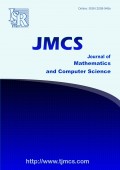Simulating a State of the Art Agent Based System with Fuzzy Reasoning for Supply Chain Coordination
-
2500
Downloads
-
3871
Views
Authors
A. Shemshadi
- Postgraduate student at the department of information technology & industrial engineering, K. N. Toosi University of Technology, Tehran, Iran
H. Shirazi
- Associate Professor at the department of information and communication technology, Malek Ashtar University of Technology, Tehran, Iran
M. J. Tarokh
- Associate Professor at the department of information technology & industrial engineering, K. N. Toosi University of Technology, Tehran, Iran
Abstract
With the emergence of high speed wireless networks and parallel advancements in Internet based technologies such as the Semantic Web, Web Services, Multi Agent Systems, and Context Awareness, the realization of the vision of the intelligent wireless web (IWW) has become a possibility. On the other side, recent developments in the field of multi criteria decision making, have led us to more accurate and applicable algorithms. In this paper, we are going to summarize the details and results of a multidisciplinary agent based software, namely SWESS that enables real-time supply chain coordination through taking advantage of different methods of different scientific areas such as computer science, supply chain management and multi criteria decision making.
Share and Cite
ISRP Style
A. Shemshadi, H. Shirazi, M. J. Tarokh, Simulating a State of the Art Agent Based System with Fuzzy Reasoning for Supply Chain Coordination, Journal of Mathematics and Computer Science, 1 (2010), no. 4, 293--304
AMA Style
Shemshadi A., Shirazi H., Tarokh M. J., Simulating a State of the Art Agent Based System with Fuzzy Reasoning for Supply Chain Coordination. J Math Comput SCI-JM. (2010); 1(4):293--304
Chicago/Turabian Style
Shemshadi, A., Shirazi, H., Tarokh, M. J.. " Simulating a State of the Art Agent Based System with Fuzzy Reasoning for Supply Chain Coordination." Journal of Mathematics and Computer Science, 1, no. 4 (2010): 293--304
Keywords
- Supply chain coordination
- supply chain management
- multi-criteria decision making
- multi agent systems
- artificial intelligence
MSC
References
-
[1]
T. Kaihara, Multi-agent based supply chain modeling with dynamic environment, International Journal of Production Economics, 85 (2003), 263--269
-
[2]
M. J. Tarokh, J. Soroor, Supply Chain Management Information Systems Critical Failure Factors, European Management & Technology Conference of Technology Research Institute of Florida, 2005 (2005), 425--431
-
[3]
T. W. Malone, K. Crowston , The interdisciplinary study of coordination, ACM Computer Surveys, 26 (1994), 87--119
-
[4]
X. H. Li, Q. Wang, Coordination mechanisms of supply chain systems, Eur. J. Oper. Res., 179 (2006), 1--16
-
[5]
C. J. Anumba, Z. Aziz, E. Obonyo, Mobile Communications in Construction-Trends and Prospects, C. J. Anumba, “Innovative Developments in Architecture, Engineering and Construction, Innovative Developments in Architecture, Engineering and Construction, 2003 (2003), 159--168
-
[6]
H. P. Alesso, C. F. Smith, The Intelligent Wireless Web, Addison-Wesley Professional, U.S.A. (2002)
-
[7]
Z. Aziz, C. J. Anumba, D. Ruikar, P. Carrillo, D. Bouchlaghem, Intelligent wireless web services for construction--A review of the enabling technologies, Automation in Construction, 15 (2006), 113--123
-
[8]
J. Soroor, M. J. Tarokh, A. Shemshadi, Initiating a state of the art system for real-time supply chain coordination, Eur. J. Oper. Res., 196 (2009), 635--650
-
[9]
T. M. Simatupang, I. V. Sandroto, S. B. H. Lubis, Supply chain coordination in a fashion firm, Supply Chain Manag., 9 (2004), 256--268
-
[10]
T. M. Simatupang, A. C. Wright, R. Sridharan, The knowledge of coordination for supply chain integration, Business Process Management Journal, 8 (2002), 289--308
-
[11]
M. J. Tarokh, J. Soroor, Using Enterprise Resource Planning Tools in Real time Supply Chain Coordination, 2nd International Conference on Information Management and Business (Sydney), 2006 (2006), page 186
-
[12]
H. L. Lee, Aligning supply chain strategies with product uncertainties, Calif. Manage. Rev., 44 (2002), 105--119
-
[13]
B. Fugate, F. Sahin, J. T. Mentzer, Supply Chain Coordination Mechanisms, Journal of business Logistics, 27 (2006), 129--161
-
[14]
, http://spacelogistics.mit.edu., , (),
-
[15]
T. L. Saaty, Fundamentals of the Analytic Network Process, ISAHP Japan, 1999 (1999), 12--14
-
[16]
T. L. Saaty, Decision Making with Dependence and Feedback: The Analytic Network Process, RWS Publications, Pittsburgh (1996)
-
[17]
, http://www.fipa.org/, , (),
-
[18]
H. Jagdev, A semantic web service environment for B2B and B2C auction applications within extended and virtual enterprises, Computers in Industry , 59 (2008), 786--797
-
[19]
H. K. Lin, J. A. Harding, A manufacturing system engineering ontology model on the semantic web for inter-enterprise collaboration, Computers in Industry , 58 (2007), 428--437
-
[20]
, http://protege.stanford.edu/, , (),
-
[21]
, http://www.w3.org/TR/owl-ref/, , (),
-
[22]
A. Shemshadi, J. Soroor, M. J. Tarokh, Implementing a Multi-Agent System for the Real-time Coordination of a Typical Supply Chain Based on the JADE Technology, Third IEEE SMC International Conference on System of Systems Engineering (SoSE'08), 2008 (2008), 1--6
-
[23]
D. Reid, N. R. Sanders, Operations Management, John Wiley & Sons, New York (2002)
-
[24]
E. Turban, R. K. Rainer, R. E. Potter, Introduction to Information Technology, John Wiley & Sons, 2005 (2005), 247--248
-
[25]
J. Soroor, M. J. Tarokh, A. Shemshadi, Theoretical and practical study of supply chain coordination, Journal of Business and Industrial Marketing, 24 (2009), 131--142

